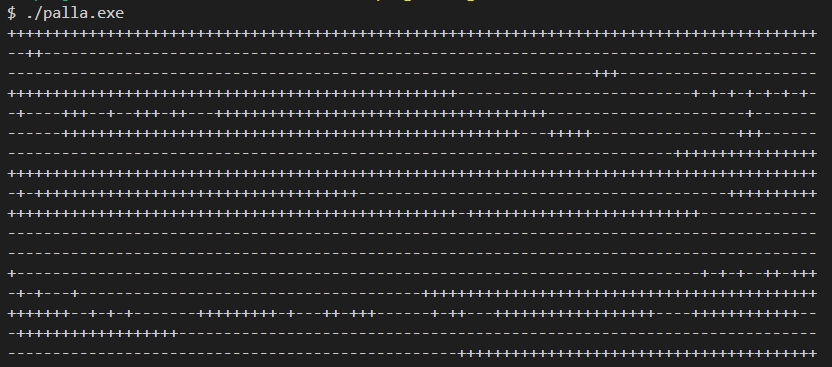Multi-threading example
การเขียนโปรแกรมแบบ single process (ไม่มี thread)
เป็นการเขียนโปรแกรมแบบดั้งเดิมโดยให้โปรแกรมทำงานตั้งแต่บนลงล่าง โดยการใช้หน่วยประมวลผลหน่วยเดียวในการแบ่งทรัพยากรณ์การคำนวณทั้งหมด
#include <iostream>
#include <vector>
#include <thread>
using namespace std;
int main(){
while(1)
cout << "+" ;
while(1)
cout << "-" ;
return 0;
}เมื่อทำการเขียนโปรแกรมข้างต้นสำเร็จ ให้ทดลองรันโปรแกรมที่เขียนมา และทำการสังเกตุผลที่เกิดขึ้น

จากผลการรันจะเห็นได้ว่า โปรแกรมที่เราเขียนนั้นจะทำการแสดงผลเพียงแค่เครื่องหมาย “+” เท่านั้น เพราะเงื่อนไข loop while ในโปรแกรมนั้นมีค่าเป็นจริงตลอด ทำให้โปรแกรมที่เราอยากให้รันได้ใน loop ที่สองนั้นไม่ทำงาน
การเขียนโปรแกรมแบบ single thread
จะมีความใกล้เคียงกับการเขียนโปรแกรมแบบ single process แต่จะเป็นการสร้าง thread ขึ้นมา thread เดียวเพื่อแยกการคำนวณออกจาก main thread
จากโปรแกรมด้านบน จะเห็นได้ว่าเราสร้าง thread ขึ้นมาเพื่อไปเรียกฟังก์ชั่น threadFn

จากผลการรันจะเห็นได้ว่าโปรแกรมรันเหมือนโปรแกรมทั่วไปที่เราเขียน แต่ถ้าเราลองสลับบรรทัดที่ 11 กับ 12 เราจะเห็นได้ว่า คำว่า “Output main” จะไม่ได้แสดงในตำแหน่งเดิม ให้ผู้ทดลอง ลองสลับและทำการรันขึ้นมาอีกครั้ง สังเกตุการเปลี่ยนแปลง
การเขียนโปรแกรมแบบ single thread แบบรับ argument
การเขียนโปรแกรมแบบนี้จะมีความใกล้เคียงกับการเขียนโปรแกรมแบบ single thread แต่จะเป็นการสร้าง thread ขึ้นมาโดยที่ตัว thread นั้นจะรับค่าที่ส่งจาก main thread ไปประมวลผลต่อใน thread
จากโปรแกรมด้านบน จะเป็นการสร้าง thread และทำการส่งค่าไปให้ thread แระมวลผลโดยค่าที่ส่งไป จะเป็นในลักาณะ pointer เนื่องจากค่าที่อยู่ใน thread เปลี่ยนแปลงค่าที่อยู่ใน main thread ก็เปลี่ยนแลงเช่นกันแม้จะไม่มีการส่งค่ากลับ

การเขียนโปรแกรมแบบ Multi thread
การเขียนแบบนี้จะเป็นการสร้าง thread ขึ้นมามากกว่า 1 thread ในการช่วบประมวลผลยิ่งจำนวน thread เยอะการประมวลผลก็ใช้เวลาน้อยลงด้วยเช่นกัน แต่อย่างไรก็ตามเมื่อ thread มีจำนวนมากขึ้นแต่จำนวน memory ที่มีไม่ได้มีมากขึ้นตามอาจทำให้การคำนวณเกิดการผิดพลาดได้ถ้ามี thread ใด thread หนึ่งไปใช้ memory ที่เดียวกัน
จากโปรแกรมด้านบนจะเป็นการสร้าง thread ขึ้นมา 2 thread แต่ละเส้นทำงานต่างกัน เมื่อทำการรันโปรแกรมจะได้ดังรูป

จะเห็นได้ว่าเมื่อเราสั่งโปรแกรมให้รันใน thread ต่างกันโปรแกรมเราจะแสดงทั้งลูปที่แสดงผลค่า “+” และค่า “-” แม้ทั้งสอง loop จะไม่มี loop ไหนจบลงเลยก็ตาม
Last updated
Was this helpful?